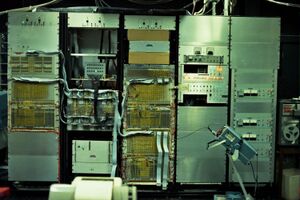Difference between revisions of "BCC 500"
(Shared memory.) |
(Also 940 instruction set.) |
||
| (12 intermediate revisions by 2 users not shown) | |||
| Line 1: | Line 1: | ||
[[Image:BCC-500_1.jpg|300px|right|thumb|BCC 500]] | [[Image:BCC-500_1.jpg|300px|right|thumb|BCC 500]] | ||
| − | The '''BCC 500''' was a computer made by the Berkeley Computer Corporation. When the company went bankrupt, the prototype | + | The '''BCC 500''' was a computer made by the [[Berkeley Computer Corporation]]. When the company went bankrupt in 1971, the prototype was sold to University of Hawaii. After two years of refurbishment it was successfully deployed as an [[ARPANET]] host until 1980. It was also the hub of the [[ALOHA network]] which inspired [[Ethernet]]. |
| − | + | The computer consists of six independent [[microcode]]d processors, having a 24-bit word width, 18-bit addressing, and access to a shared memory. The microcode implements an [[instruction set]] with a 6-bit [[operation code|opcode]] and 18-bit [[address]] field, as well as a subset of the [[SDS 940|940]] instruction set. Two of the processors have expanded hardware capabilities and run user code. The other four are each responsible for implementing their own part of the [[operating system]]; part in microcode and part in macrocode. | |
| − | + | At BCC, an [[IBM System/360|IBM 360/30]] acted as a [[front end]], handling tape drives, card readers, and printers. This was replaced by a [[Hewlett-Packard|HP]]2100A at Hawaii. A [[PDP-11/10]] running [[ELF operating system|ELF]] connected to the [[ARPANET]]. | |
{{semi-stub}} | {{semi-stub}} | ||
| Line 11: | Line 11: | ||
== External links == | == External links == | ||
| − | * | + | * [http://www.bitsavers.org/pdf/bcc/ BCC] - documentation at [[Bitsavers]] |
| − | * | + | * [http://www.bitsavers.org/pdf/univOfHawaii/Aloha_BCC-500/ Aloha BCC-500] - more |
| + | ** [http://www.bitsavers.org/pdf/univOfHawaii/R-1_BCC500_DesignFeatures_Rev_Mar74.pdf Design Features of the BCC 500 CPU] | ||
| + | ** [http://www.bitsavers.org/pdf/univOfHawaii/Aloha_BCC-500/pictures/hawaii_bcc500_block_diagram.jpg BCC500 block diagram] | ||
| + | ** [http://www.bitsavers.org/pdf/univOfHawaii/Aloha_BCC-500/logbooks/Last_BCC500_HW_Log_Entry_19800229.pdf Last BCC500 Log Entry] | ||
| + | ** [http://www.bitsavers.org/bits/UniversityOfHawaii/BCC-500/ Tape image "BCC 500 Proof Tape] | ||
| + | * [http://bwlampson.site/06a-BCC500Notes/06a-BCC500Notes.pdf Some Remarks on a Large New Time-Sharing System] | ||
| + | * [http://bwlampson.site/06-DynamicProtect/06-DynamicProtect.pdf Dynamic protection structures] | ||
[[Category: Mainframes]] | [[Category: Mainframes]] | ||
| + | [[Category: 24-bit Computers]] | ||
| + | [[Category: Unique Computers]] | ||
Latest revision as of 13:59, 11 March 2024
The BCC 500 was a computer made by the Berkeley Computer Corporation. When the company went bankrupt in 1971, the prototype was sold to University of Hawaii. After two years of refurbishment it was successfully deployed as an ARPANET host until 1980. It was also the hub of the ALOHA network which inspired Ethernet.
The computer consists of six independent microcoded processors, having a 24-bit word width, 18-bit addressing, and access to a shared memory. The microcode implements an instruction set with a 6-bit opcode and 18-bit address field, as well as a subset of the 940 instruction set. Two of the processors have expanded hardware capabilities and run user code. The other four are each responsible for implementing their own part of the operating system; part in microcode and part in macrocode.
At BCC, an IBM 360/30 acted as a front end, handling tape drives, card readers, and printers. This was replaced by a HP2100A at Hawaii. A PDP-11/10 running ELF connected to the ARPANET.
